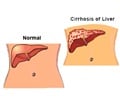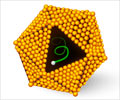Diagnosis
Rust colored rings called - Kayser-Fleischer rings are a hallmark of Wilson’s Disease
The diagnosis of Wilson’s is rather difficult as most of the symptoms are similar to other diseases, especially those connected to the liver. Once Wilson’s is suspected there are some simple tests to be done.
Usually the presence of rust colored rings (Wilson’s Disease) seen through an ophthalmologist’s lens is enough to confirm the suspicion of this disease. Other lab tests are done to further confirm its presence. These tests are also used in absence of the ring if the disease is suspected.
- Approximately 90% of all patients with Wilson disease have ceruloplasmin levels of less than 20 mg/dL (reference range, 20-40 mg/dL).
- 24-hr Urine Copper level - This is used for screening patients suspected of having Wilson’s Disease. Urinary copper excretion is greater than 100 mg/24hrs (reference range – 20 to 50 mg/24 hrs) in most patients with symptomatic The collection container should be free of copper contamination and the test should be done in a well standardized labs.
The test is also done to evaluate the response to chelation therapy against copper levels in a patient.
- Concentration test - This test is regarded as the main criteria for diagnosis of Wilson disease. A normal hepatic copper concentration (reference range, 15-55 mcg/g) effectively excludes the diagnosis of untreated Wilson disease.
- Radio- labeled Copper - Radio-labeled copper testing directly assays hepatic copper metabolism. In healthy people, reappearance of the radioactivity in serum occurs as the labeled copper is incorporated into newly synthesized ceruloplasmin and released into the body, does not exhibit the secondary rise in radioactivity.









